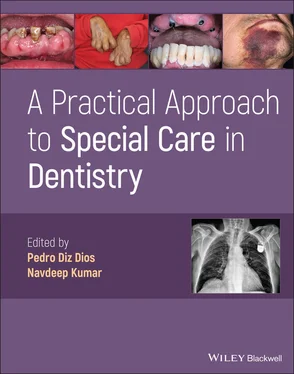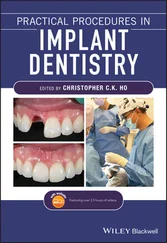A Practical Approach to Special Care in Dentistry
Здесь есть возможность читать онлайн «A Practical Approach to Special Care in Dentistry» — ознакомительный отрывок электронной книги совершенно бесплатно, а после прочтения отрывка купить полную версию. В некоторых случаях можно слушать аудио, скачать через торрент в формате fb2 и присутствует краткое содержание. Жанр: unrecognised, на английском языке. Описание произведения, (предисловие) а так же отзывы посетителей доступны на портале библиотеки ЛибКат.
- Название:A Practical Approach to Special Care in Dentistry
- Автор:
- Жанр:
- Год:неизвестен
- ISBN:нет данных
- Рейтинг книги:3 / 5. Голосов: 1
-
Избранное:Добавить в избранное
- Отзывы:
-
Ваша оценка:
- 60
- 1
- 2
- 3
- 4
- 5
A Practical Approach to Special Care in Dentistry: краткое содержание, описание и аннотация
Предлагаем к чтению аннотацию, описание, краткое содержание или предисловие (зависит от того, что написал сам автор книги «A Practical Approach to Special Care in Dentistry»). Если вы не нашли необходимую информацию о книге — напишите в комментариях, мы постараемся отыскать её.
Learn to treat dental patients with disabilities or who are medically compromised A Practical Approach to Special Care in Dentistry
A Practical Approach to Special Care in Dentistry
A Practical Approach to Special Care in Dentistry — читать онлайн ознакомительный отрывок
Ниже представлен текст книги, разбитый по страницам. Система сохранения места последней прочитанной страницы, позволяет с удобством читать онлайн бесплатно книгу «A Practical Approach to Special Care in Dentistry», без необходимости каждый раз заново искать на чём Вы остановились. Поставьте закладку, и сможете в любой момент перейти на страницу, на которой закончили чтение.
Интервал:
Закладка:
Clinical Presentation
In March 2017, the International League Against Epilepsy (ILAE), a group of the world's leading epilepsy professionals, introduced a new method to group seizures ( Table 1.2.3). The main changes are:‘Partial’ becomes ‘focal’‘Awareness’ is used as a classifier of focal seizuresThe terms dyscognitive, simple partial, complex partial, psychic and secondarily generalized are eliminatedNew focal seizure types include automatisms, behaviour arrest, hyperkinetic, autonomic, cognitive and emotionalAtonic, clonic, epileptic spasms, myoclonic and tonic seizures can be of either focal or generalised onsetFocal to bilateral tonic–clonic seizure replaces secondarily generalised seizure Table 1.2.3 New classification of epilepsy.Source: Adapted from Scheffer, I.E., Berkovic, S., Capovilla, G. et al. (2017). ILAE classification of the epilepsies: Position paper of the ILAE Commission for Classification and Terminology. Epilepsia 58: 512–21.Type of seizureType of epilepsy (EEG activity)AetiologyFocalGeneralisedUnknownFocalGeneralisedGeneralised and focalStructuralGeneticInfectiousMetabolicImmuneUnknownNew generalised seizure types are absence with eyelid myoclonia, myoclonic absence, myoclonic–atonic, myoclonic–tonic–clonicSeizures of unknown onset may have features that can still be classified
In view of this, seizures are divided into 3 main groups depending on:Site of onset in the brain: focal/generalised/unknownLevel of awareness: aware/impairedPresence of other symptoms: motor/non‐motor
This is summarised in Table 1.2.4
Diagnosis
The diagnosis is established mainly based on clinical findings and electroencephalograms (EEGs) ( Figure 1.2.6) Table 1.2.4 Clinical presentation of seizures.Source: Adapted from Scheffer, I.E., Berkovic, S., Capovilla, G. et al. (2017). ILAE classification of the epilepsies: Position paper of the ILAE Commission for Classification and Terminology. Epilepsia 58: 512–521.Type of seizureCharacteristicsSigns/symptomsFocal onset (may affect one lobe or a large part of one hemisphere)Focal aware or focal impaired awarenessMotor onset or non‐motor onsetCan be followed by a bilateral tonic–clonic seizureMotor symptomsAutomatisms (lip‐smacking, chewing movements, running, cycling, kicking, repeatedly picking up objects or pulling at clothes)Loud cry or screamTwitching, jerking or stiffening movements of a body partSudden loss of muscle tone or limbs suddenly becoming stiffNon‐motor symptomsChanges in sensation, emotions, experiencesFeeling of déjà vu (feeling like you have been here before)Unusual smell or tasteSudden intense feeling of fear or joyNumbness or tinglingVisual disturbances (coloured/flashing lights or hallucinations)Generalised onsetMotor (tonic–clonic/other) or non‐motor (absence)Tonic–clonicTypically last 1–3 minAt the start of the seizure:The person becomes unconsciousBody goes stiff and they may fallMay cry outMay bite their tongue or cheekDuring the seizure:Jerk and shake as their muscles relax and tighten rhythmicallyBreathing might be affected and become difficult or sound noisySkin may change colour and become very pale or bluishIncontinence may occurAfter the seizure:Often feel tired, confused, have a headache or want to sleepAbsenceMore common in childrenCan be frequentLast a few secondsTypical absences: ‘daydreaming’, blank, unresponsive, may be missedAtypical: start and end more slowly, can last longer, may also include reduced muscle toneUnknown onsetMotor (tonic/clonic/epileptic spasms) or non‐motorVariable symptoms as described aboveUnclassifiedDue to inadequate information/inability to place in the above categories Figure 1.2.6 Electroencephalogram (EEG) showing epileptiform activity.
High‐resolution structural images (high‐field magnetic resonance) and functional radionuclide imaging (positron emission tomography/single‐photon emission computed tomography) can be useful ( Figure 1.2.7)
Genetic testing has gained importance in diagnosing some forms of epilepsy
Management
Drug treatment with glutamate inhibitors (e.g. carbamazepine, lamotrigine, phenytoin and topiramate)
Gamma‐aminobutyric acid enhancers (e.g. barbiturates, benzodiazepines, gabapentin, primidone, tiagabine, valproate and vigabatrin) Figure 1.2.7 Magnetic resonance imaging (MRI) can identify structural changes in the brain that may cause seizures.
Surgery for drug‐resistant focal epilepsy (resection or disconnection of a circumscribed cerebral area, or vagal nerve stimulation)
Prognosis
The prognosis is determined by the underlying disease, the extent of the brain damage and the severity and frequency of the seizures
The estimated mortality of status epilepticus (generalised tonic–clonic seizures that last more than 5 minutes) is approximately 20%
The risk of premature death in people with epilepsy is up to 3 times higher than for the general population
A World/Transcultural View
Approximately 80% of people with epilepsy live in low‐ and middle‐income countries
Unfortunately, 75% of people with epilepsy living in low‐income countries do not receive the treatment they need
In many parts of the world, people with epilepsy and their families suffer from stigma and discrimination
The religious beliefs prevalent in some countries have resulted in a portion of the population still believing that epilepsy is caused by supernatural possession, resorting to religious healing for its treatment
In Africa, Asia and Latin America, alternative therapies such as medicinal herbs are often used to treat epilepsy (e.g. rhizomes of Acorus calamus and leaves from the Bacopa monnieri plant), most of which have not been pharmacologically evaluated
The socio‐economic and cultural environment significantly affects accessibility to drug treatment, which can jeopardise access for 75–90% of individuals with potentially treatable epilepsy in low‐income countries
Recommended Reading
1 Aragon, C.E. and Burneo, J.G. (2007). Understanding the patient with epilepsy and seizures in the dental practice. J. Can. Dent. Assoc. 73: 71–76.
2 Cornacchio, A.L., Burneo, J.G., and Aragon, C.E. (2011). The effects of antiepileptic drugs on oral health. J. Can. Dent. Assoc. 77: b140.
3 Davidson, G.T., Eaton, M., and Paul, S.P. (2016). Childhood epilepsy: a clinical update. Community Pract. 89: 25–29.
4 Fiske, J. and Boyle, C. (2002). Epilepsy and oral care. Dent. Update 29: 180–187.
5 Morgan, H.I., Abou, E.F.R.K., Kabil, N.S., and Elagouza, I. (2019). Assessment of oral health status of children with epilepsy: a retrospective cohort study. Int. J. Paediatr. Dent. 29: 79–85.
6 Robbins, M.R. (2009). Dental management of special needs patients who have epilepsy. Dent. Clin. North Am. 53: 295–309.
7 Schöpper, M., Ludolph, A.C., and Fauser, S. (2016). Dental care in patients with epilepsy: a survey of 82 patients and their attending dentists and neurologists in southern Germany. Int. Dent. J. 66: 366–374.
8 Thijs, R.D., Surges, R., O'Brien, T.J., and Sander, J.W. (2019). Epilepsy in adults. Lancet 393: 689–701.
1.3 Muscular Dystrophy
Section I: Clinical Scenario and Dental Considerations
Clinical Scenario
A 15‐year‐old patient is referred by the Ear, Nose and Throat (ENT) specialist for an orthodontic assessment. There is concern that the patient's palatal morphology may be responsible for his chronic nasal respiratory distress ( Figure 1.3.1).
Medical History
Child of a primiparous mother who had Steinert myotonic myopathy (also known as myotonic dystrophy type 1)
Читать дальшеИнтервал:
Закладка:
Похожие книги на «A Practical Approach to Special Care in Dentistry»
Представляем Вашему вниманию похожие книги на «A Practical Approach to Special Care in Dentistry» списком для выбора. Мы отобрали схожую по названию и смыслу литературу в надежде предоставить читателям больше вариантов отыскать новые, интересные, ещё непрочитанные произведения.
Обсуждение, отзывы о книге «A Practical Approach to Special Care in Dentistry» и просто собственные мнения читателей. Оставьте ваши комментарии, напишите, что Вы думаете о произведении, его смысле или главных героях. Укажите что конкретно понравилось, а что нет, и почему Вы так считаете.












